My Goals
I have probably owned or used just about every type of plane and saw produced, be they the lowest of the low end and the highest of the high end and then those in between. That’s not altogether true, but I have used a lot. One of the nicest planes I ever used to plane with was one made by my friend. It was completely hand made with dovetailed sole to sides individually filed and then peened in place for permanence. It was rosewood infilled and it fit my hand like a glove. He took five weeks full time to make it and when it was done I felt it was the loveliest plane I had ever seen. I never saw the plane or my friend again. Though I did enjoy seeing the skilled workmanship he put into the plane, and I would have enjoyed having it on a shelf in my living room somewhere, it wasn’t really my idea of a user plane. More a luxury in the making and a luxury in the owning of it This is where the story ends for me. I do have some collectable tools I enjoy owning, but the ones I enjoy the most are the ones I use.
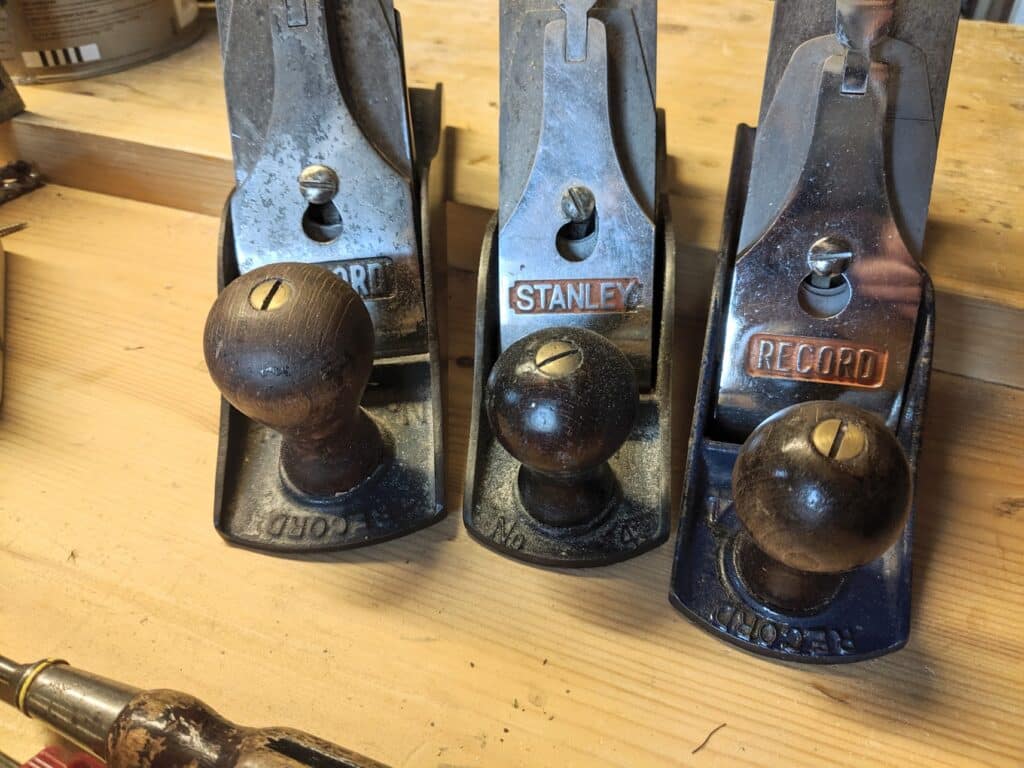
I have only admiration for those who have made a business out of making high-end planes, especially those like my friend who create absolute works of art in the doing of it using their hands, eyes and skilled filing and fettling and minimal use of milling machines and so on, but imagine how Leonard Bailey felt when he developed his own pattern of plane that would indeed displace all others on the market. The stupid thing is as it is with many tool making businesses. They truly think they’re big enough and strong enough not to keep pace and up to date with market changes and the changes in people’s (their customer’s) attitudes. They never saw that people would buy a higher end plane as they sacrificed quality in materials and workmanship. For Stanley or Record to put out a decent quality plane that would satisfy any crafting artisan whether professional or amateur, and amateurs are much higher demanding, would take about five more minutes of a persons time and a few pence more in materials. Truth is most people would have willingly paid twice as much for the planes. They just couldn’t see it. That is mostly how higher end makers made it. If they could send a plane out sharp and ready top go straight from the box, they would win. They didn’t have to invent a single thing, just create their own knock offs of what was already out there but better. Not much to it really.
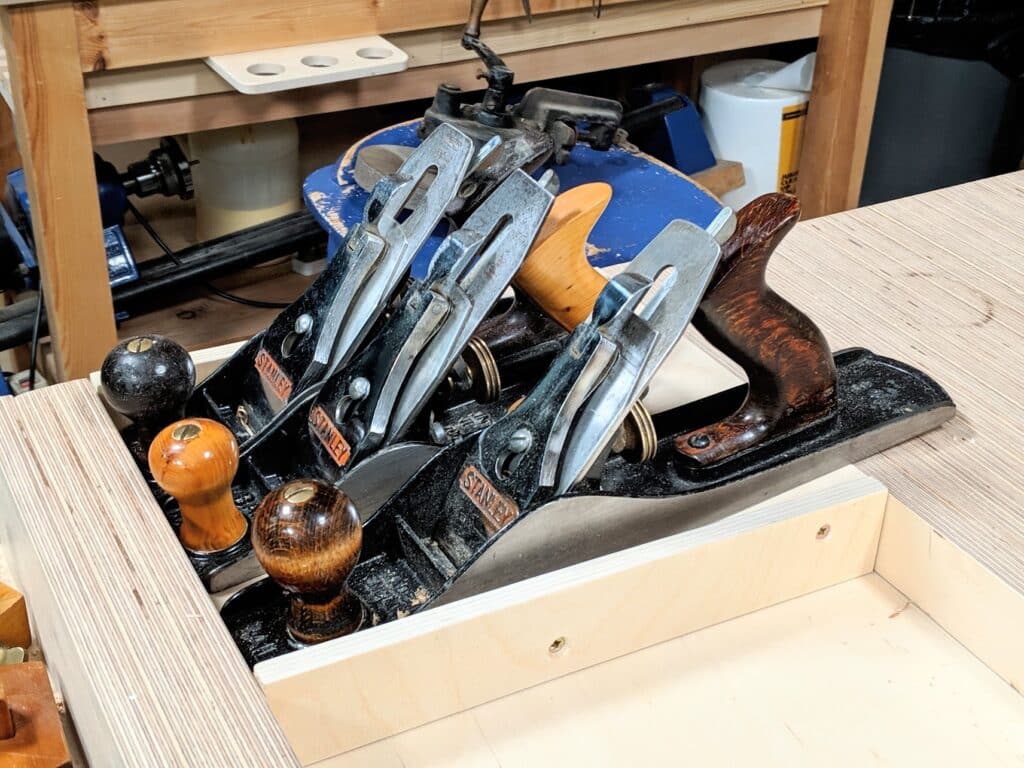
My planes are more the UK made Stanley and Record types I grew up with. I have an affection for them, I know I do. They seem to me to be well balanced and I switch between the #4s and the #4 1/2s de[ending on the widths of shaving I want, the work in hand and then the weight to strength ration I like to mix and match in plane-to-task measure. Because these planes are so inexpensive and plentiful, and they work as well as every high end plane and any in between, I think you should in fact own two or three for efficiency. I save a great deal of time by sharpening several planes at the same time and that indeed puts distance between sharpenings too.
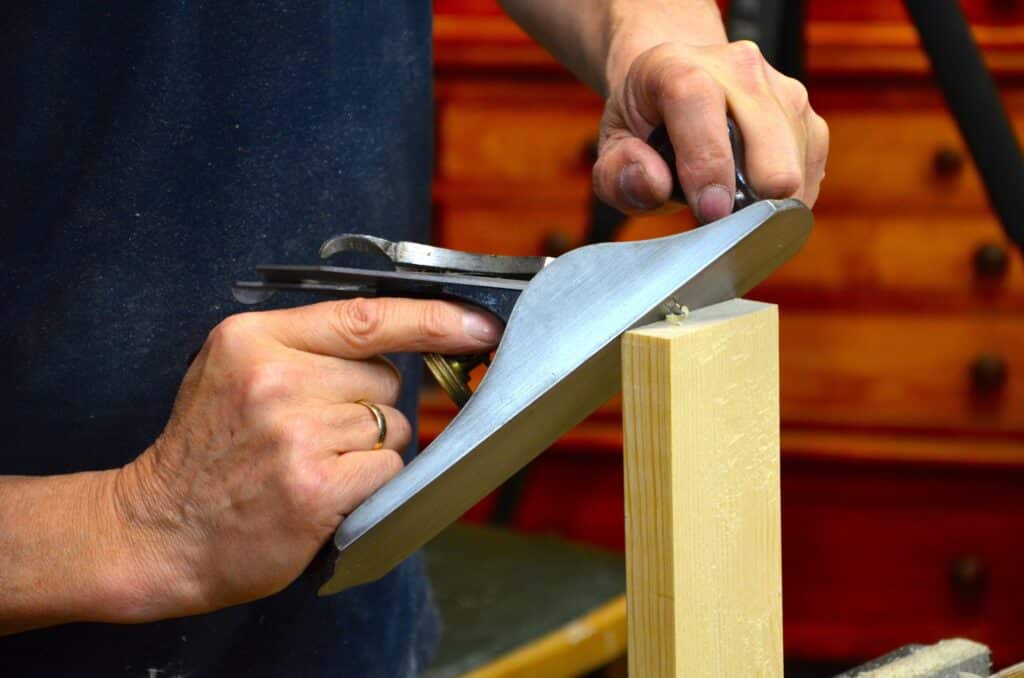
Some say that modern steels keep their edge longer. I am sure that that’s the case, somewhat anyway.Whether anyone has really been able to measure this for themselves and by how much longer is questionable. And then too, always remember that when a blade or cutting iron is indeed made of a harder steel alloy it also takes more effort and longer to develop a sharpened edge. Personally sharpening up frequently is always my preference. I like the crispness regular sharpening gives to me and only laziness prevents it. I have a system with my planes off camera where I use two and even three of same planes of the same size alongside one another. The duller one prefaces a next level for roughing off unevenness and need not be pristinely sharp all of the time. I then follow on with the sharper ones so I use the dull one until I need to sharpen ahead of the sharper ones. I then sharpen up all of the planes and cycle through again. It’s worked for me for years.
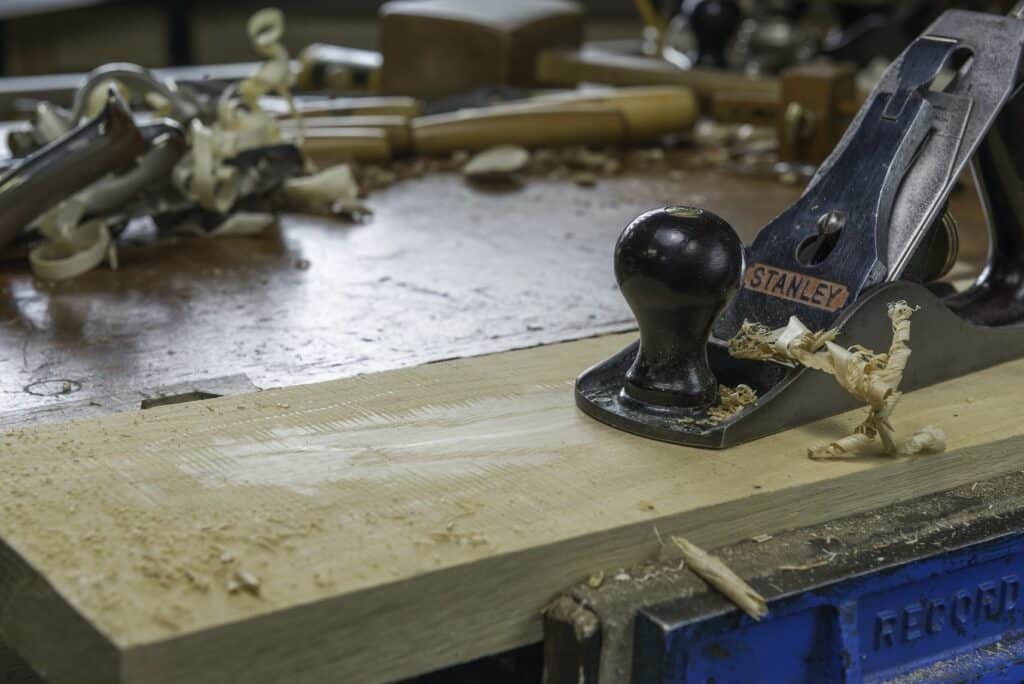
It’s questionable whether heavy planes are as practicable in real life but some people just admire heavy equipment in the same way they admire Tonka trucks as children that extenuate into adult life with one-ton dually four-wheelers as city-slicker images they have of themselves. I am always amazed that with all of the scientific data at a single click we don’t reevaluate what, where and how we drive. I have done this with regards to the extent I use my own energies at the workbench with the tools I use. For me, because all of my planing is by hand, a heavy plane used for over two hours in a given day translates into bench lifting hundreds of pounds over the amount I need to in a given period. Were I to do that I would not get thew work done that I have in mind and I would indeed be exhausted with a misuse of my stamina. Every time I pick up a heavier #4 I rapidly return it to the bench and plumb for a Stanley. I have yet to find a heavy plane that will do more than a light one. Those advocating heavy planes are usually selling them somewhere in the chain.
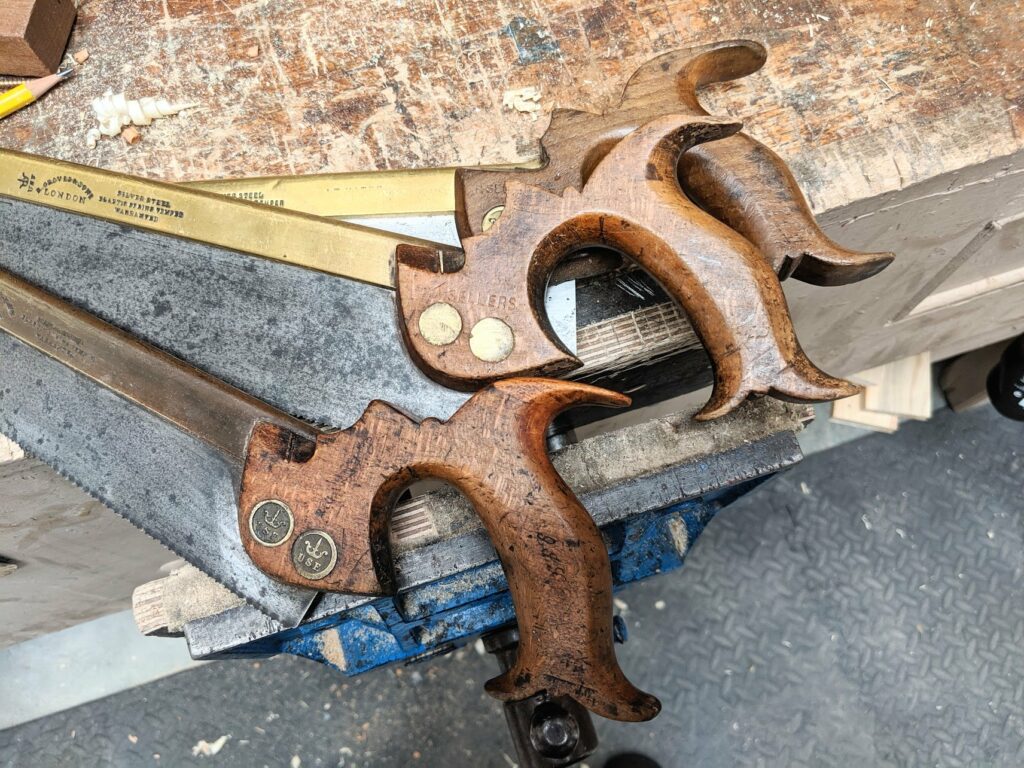
With regards to handsaws, tenon saws and such I feel the same way except for some reason advocates have never suggested heavier saws, but more the lightweight disposable types you pull instead of push. Here again I have shown how simply sharpening any new saw, including the so-called premium versions, are always improved by just touching up the teeth with single stroke, a good fine file and a light touch. Whether you buy new ones or old ones, premium ones or relatively inexpensive versions, each and every saw needs sharpening soon. It is my experience that moist people defer sharpening till way after they should. They think that a saw that cuts reasonably is good enough but generally it’s not. I like to take care if my saws with a single pass, quickly, and then get to task. The only time I need to reshape a tooth is when I buy a secondhand saw that’s generally been neglected, abused or both.
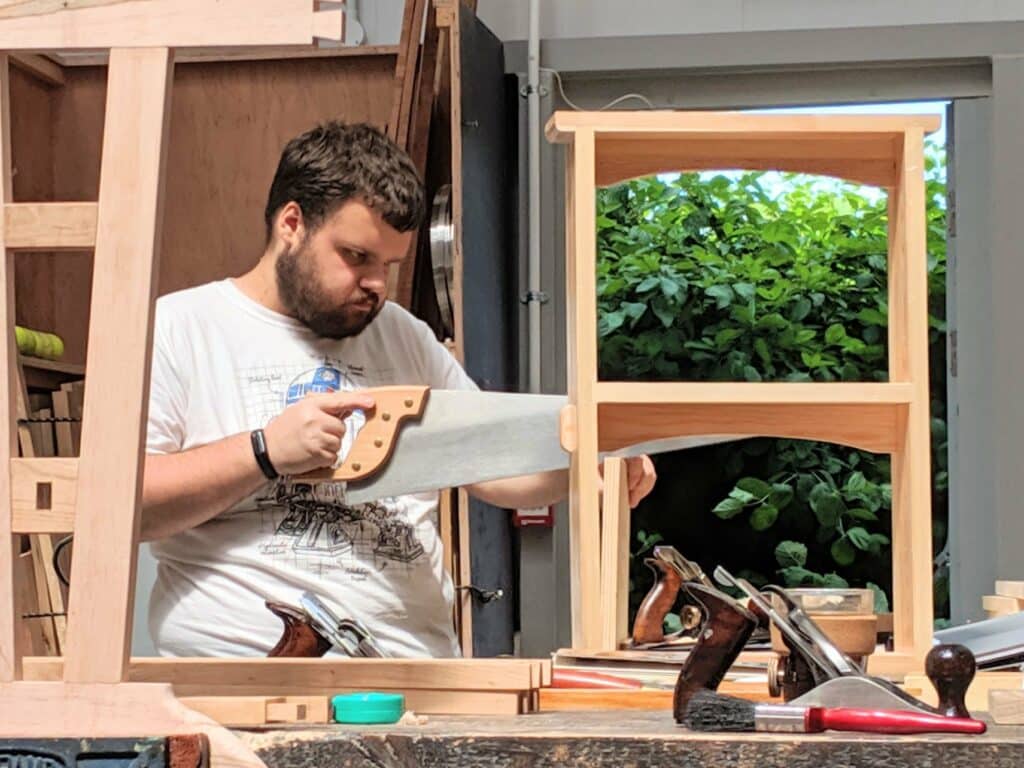
Matching work to weight, to strength to wood and many more is for me the more critical. Taking successive full width shavings from one end to another on perfectly aligned grain and reasonably straight wood proves almost nothing, and that’s no matter the wood too. Ten strokes or so only dulls the cutting iron by a little. You can do this with most planes even when the sole is hollow or round. Where it’s most important is at the intersections of jointed areas where you plane up to an adjacent unlevel part you must reduce to some great or lesser degree to make the surface align perfectly. Fitting drawer sides and widths to cases too is little to do with the need if a heavy plane, a thick iron and extra hardened steel. My lightweight Stanley, I weight them all and they can markedly differ, is amazing in the fray of wild grain taming. It whips and spins with the ease of an Arabian gelding and is as precisely accurate as a Westphalian dressage champion.
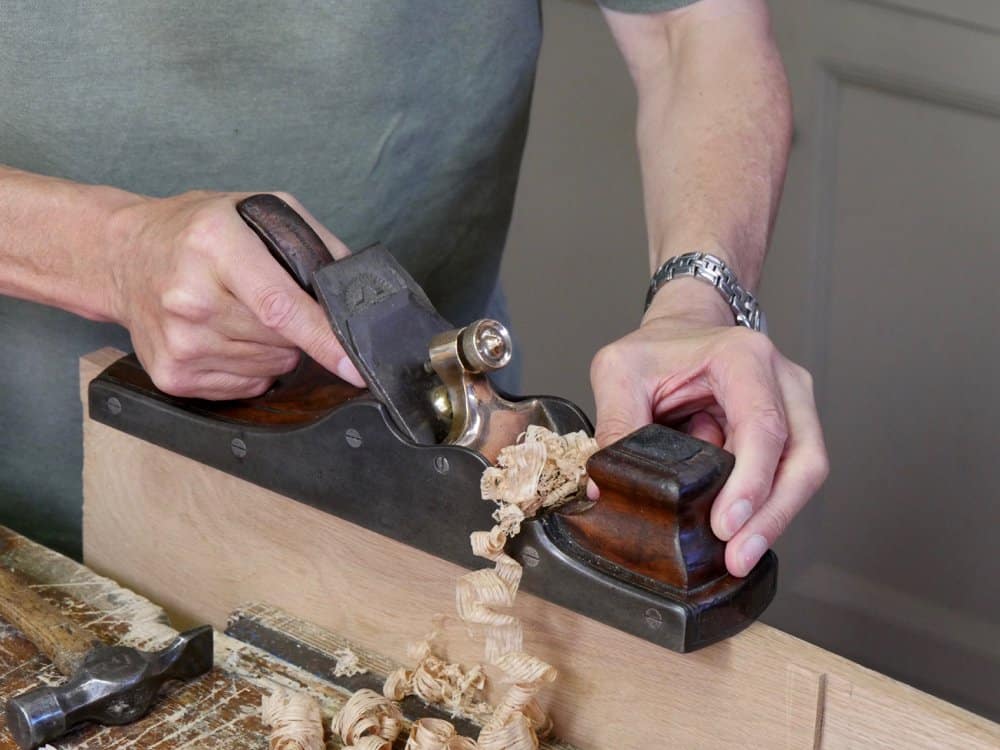
Convincing others that the basic #4 bench plane by Stanley and Record will likely be your very best choice has been somewhat difficult but I think that that is more to do with people relying on the maxim, ‘You get what you pay for.’ Whereas that can be true, many fail to remember that the Bailey pattern planes made by Stanley and Record have a well proven track record spanning a century and a half with almost no changes through their extensive history. It’s only in latter times, to their shame, that the quality has deteriorated but in any given day you will have a hundred planes to pick from on eBay and rarely will you need top pay more than £25 a pop.


This article is interesting as ever, and I do enjoy your reflections on various tools. Of course, 50 or so years of continuous evaluation does give your reports a greater degree of authority than many other reviewers.
It’s an interesting coincidence that this morning I’ve been given a box of oily/rusty planes. One is a grubby but complete Sargent which looks like the equivalent to a No.6. I’m just about to clean it but thought I’d have a cuppa and read your latest missive. Your blog was just right. It’s a privilege to return unloved tools to working condition, however I need to do more making and less restoration!
I have a Stanley block plane in my tool chest, among the tools that I inherited from my late Father. I was with him when he bought it in the 1960s and remember the orange cardboard box, the waxed paper and the price, written as 22/= (shillings or £1-10). Years of working with power tools, thinking them to be the key to good results have left me disillusioned. I am now relearning the satisfaction of working with hand tools. Somehow, the pile of sawdust and shavings smells sweeter than that from the power tools.
Paul, as Bach and Mozart and Chopin established for themselves a legacy in music that has stood the test of hundreds of years, so you stand as a virtuoso in the world of woodworking sure to effect within thousands the desire and skill to transform sticks into works of art for many generations to come. Thank you for everything you do!
Well that’s an interesting story re hand made plane…….what happened to it and your friend????? Or did I miss the end of the story Paul
I think the point being made was no matter how cheap or ostentatious a plane is it must be kept sharp, sharp oh and sharp. Stanley #4 is Paul’s plane of choice no matter what anything else’s price tag may suggest to layman like myself. Sorry if I’m off piste but that’s what I took the article to mean
There is no doubt the final finish you get with a hand plane is superior to any machine and the surface usually will not require sanding.
I would always use a heavier plane on the shooting board , the extra momentum gives a crisper finish.
Well said Paul for keeping the benefits of hand tool woodworking alive and well.
Regards Frank
Hand cranked grinder 🙂
Thanks again for you great insights Paul. I am lucky enough to own an English made Clifton 5 1/2 which I love but it is a heavy plane sometimes I prefer my record #6. My favourite plane though is an old Record #3 it’s light very sharp (usually) and for some reason I can’t fathom it always planes with an ease I don’t always achieve with my other planes. I am on a journey to make planes in the UK and am aiming for modern materials and usability, I’ll take your point about weight. My 1399 style router plane will be available to order in March April 2020.
Thanks again Paul for sharing your skill and knowledge, you continue to inspire me.
I’d rather not have the plug but there you go. Prefer no advertising here.
I’ve often wondered on the logic or planning with regard to the increasing bulk of the Stanley planes over the years. Seemingly regardless of the size (#3, 4, 4 1/2, 5, 5 1/2, 6, 7, 8) the older examples I’ve come across (or own) tend to have much more delicate castings for the side walls. By older I mean late 1800s to early 1900s.
I don’t know when the transition happened (or why) but by WWII the castings were significantly thicker – with a much more “chunky” appearance.
Was this a conscious design decision, or could it even simply be due to thinner castings being harder to manufacture, and more prone to warping when cooling (thus a thicker casting being easier to grind flat, and thus having a higher yield)?
I understand the rare #4 1/2 H (Heavy) was made in response to the English infill planes, so there was at least an awareness of some user’s desire for weight.
Personally I much prefer the feel of those delicate walled earlier planes – despite having pretty large hands. Can’t put my finger on why; they just feel nicer to use.
Give me a lightweight Arabian over a draft horse any day. Drafts are for pulling but Arabians spin on a dime and in a heartbeat, so too for the Arabians of bench planes no matter the length and width. Love ’em.
I heard a story from a WWII era guy. He said that when the US men went off to war, Stanley hired women. The management thought the women would need more material to achieve the machining standards the men had maintained.
They were wrong. The women did just fine. But since they were using blanks with more material, and achieved standard just as quickly as the men had, the resulting plane had more mass.
Is that true? I don’t know. But it does seem odd that in an era when steel was critical to the war effort a tool maker would use more than he previously had.
Just wondering why you didn’t mention wood constructed planes?
Michael
In what way, Michael. I have mentioned wooden planes over the years but they will never return to displace cast metal versions and the majority will never use them or have access to them. That;’s as good a reason as any. Wooden planes made by current makers are prohibitively high and woodworkers like myself could never afford to own even one. I can enjoy my vintage versions on my own. Anyone can of course by old ones for little money, but they come more often than not with built-in abuse and neglect issues.
Paul et al,
You can still buy wooden palnes made by ‘Pinie’ in the Czech Republic at quite reasonable prices – they come in several different varients with & without hornbeam soles and with and without mechanical blade adjusters. I am thinking of buying one just to see what they are like having been brough up using wooden technical jack planes when I was at school in the 1960’s.
I wouldn’t personally be looking to use wooden planes.
Mr. Sellers, I agree with what you say regarding your not mentioning wooden bodied planes here, but would like to supplement that by saying that one can make one’s own wooden bodied plane. There are methods that are quite simple and give very good results and are enjoyable projects in themselves. Irons are available and more elaborate kits that offer alternate adjustment mechanisms if desired. For not much money one can have a tool custom fitted to one’s own hand and preferences. I don’t know, objectively, how they compare to a well set up Bailey pattern plane, although I have several for comparison, but as I am sure you know well, there is a special satisfaction in using a tool one has made oneself.
Back in the 80’s, I was 16, my grandfather always said clean and look after your tools and they will look after you. When it came to planes, he showed me how to sharpen iron’s by hand in a figure eight pattern. Use the whole stone, he would say, a sharp iron makes the task feel joyful he would say. At the time my arms would ache sharpening, as my grandfather kept saying, you will thank me one day.
He was so right and I do, god bless him. I have used a mountain of different planes in my time and none work well without a proper sharp iron.
As Paul reminds us, it is not the plane that is good but the user by how they look after the plane.
Husbands have come and gone, but I’ve always managed to hang onto my 1950s Record #4. Some things in life are too important to let go.
Totally agree.
Husbands come and go
Very funny
I studied the Stanley No 4, its correction and sharpening, on the internet and YouTube. I bought a 50s model and am delighted with the results. It is good to be a proud owner! Your remarks on frequent sharpening make me wonder whether it would be a good idea to form a collection of spare blades, rather than a large collection of spare planes. The blades would tale up much less space and are really quickly and easily changed.
No, I don’t think so. It’s nice to have them ready to go and adjusted per or to the actual blade. Stacking up over states the live situation. Three #4 planes for most is enough.
I keep a spare blade in case of damage to a working blade. It can take a dedicated afternoon to repair a nicked edge. Other than that having two or three setup planes is hard to beat.
There is no way it takes a dedicated afternoon to repair a nicked edge, 10 minutes on a coarse stone unless its really bad. You should be able to take of a complete even in an hour, even without using a grinding wheel, but a grinding wheel is a few minutes only too. I would hate for anyone new to woodworking to think it takes half a day to regrind a nick from a bevel.
Well said 10 to15 minutes tops be more than a Nick to take a afternoon
I love that you say 3 #4 planes are enough as I have four currently and am prepping one to sell! So, at least I’m on the right path —
No plug, I don’t sell through myself and don’t care to sully your page.
Paul you have ignited in me a passion that has revitalized old bones. Having lost most of my mobility in a car accident I sat depressed almost static for years. I am never going to run the marathon but my need to follow this yearning inside to work with wood is all down to you and your brilliance. Your ability and the way you articulate in your blogs, videos etc I find given me a new lease of life. I thank you my friend from the bottom of my heart.
Thankyou for another interesting read. I inherited a few Stanleys from my grandfather and often work with his much used #4, however the one I seem to turn to the most is an Australian Falcon Pope #5, it just feels right!
I know what you mean. As similar as planes may be there do exist subtle differences in them that make us favor one over another. Variations cause us to feel more positive or negative coupled with the results we can achieve with particular tools influence our overall impressions as well.
I use a Shelton 14″ plane I bought as a rusted out mess for $5 on that big auction site. I wound up surface grinding the sole flat at work on my lunch break to get a slight twist out when I was restoring it. This thing is wonderful and I use it for 90% of any plane work I need to do. Even in it’s day it was a “cheapo” plane but it performs just as well as my new expensive planes and I don’t worry about dinging it or dropping it.
Love the “common sense ” thought that went into this article. I am already with you on planes with my Stanleys and Sargents. My downfall is hand saws, I am up to 12 and I am realizing several have not been used in a while. What would you consider the reasonable types to have in the rack for a small woodshop?
I am glad to have now a perspective from which my plane acquisition should not be seen as excessive, as I had begun to think it may be.
I watched a youtube of an australian who tests steels and he sharpened a power crucible steel Elmax to like 13⁰ and cut sisal rope 1300 times before the steel stopped shaving printer paper…it was still shaving the paper but for a slight hiccup here and there. Holy cow! As you say sharpening was a bear though. I have bought too many used and new wood bodied planes. I now like the way they float over the wood way better than the heavy metal planes I just want thin vs thick irons! For practical use give me a wood plane with a thin iron of the elmax with a thin bevel. Why? Yes it is hard to hog off supersteel but…with a tiny bevel you dont have to. Buy 3-4 thin irons and spend your time sharpening all at once. Then you can focus on crafting rather than reshaping soft steel when you hit lots of pine knots. Of course you dont get the practice and discipline of turning ordinary steel into a sharp cutting tool. Supersteel is kind of gimmicky.
If you have time to cut sisal rope 1300 times then you don’t have time for woodworking. Just choices we make I suppose.
Paul, you once started the making of some kind of transitional plane (like the one shown in the blog “WOODEN PLANES AND ALL METAL ONES – WHAT’S THE DIFFERENCE ANYWAY? dated 12 February 2015” [seventh picture] but I have never seen the completion of it.
Except, maybe, making another depth-adjustment slot in a cap-iron (because of the thicker sole) , would there be any other problem?
In the US, one can find transitional plane, while here on the Continent, on the flea market, one only find wooden bodied planes.
Sylvain
It was to do with copyright issues that we decided not to make the plane. You can of course make one on your own and use it yourself. I am more content with my metal planes though, and most people are too.
According to a canadian woodworking co. The pm-v11 plane blades sharpen just like high carbon steel but have twice the life for only 30% more in cost bought new…is that true? They offer stanley replacement blades.
I use A1 ,A2 and Veritas PMV_11 plane irons . It is true that the PMV_11 takes about the same to sharpen as A2 tool steel BUT it really does last twice as long in my tests . I dont know if people consider the extra price worth it though really.
Even if that was true, twice as long, it’s hardly worth the difference.
Now you’ve just expanded the lifetime of a sharp edge to twice as long whereas even the Canadian manufacturing company says up to 30% longer. Plus, how on earth are you measuring this test in the realness of working at the workbench. Bench tests by magazines are equally unreal because no two pieces of wood have the same amount of knots in them and no two pieces have the same density of grain structure. This just gets wilder and wilder with people who want to justify their purchases
You are right there’s no way to know! It is whether you trust the salesman or not…reputation i guess. We trust you so i will copy what your team does.
Figures lie and liars figure!
No idea. Remember that manufacturers and salesmen and women sell stuff and don’t actually use it. And facts are hard to prove for us little guys.
Anybody tried the wooden planes marketed by Infinity?
I’ve made a couple of Krenov style hand planes with mixed success. I’m far from being an expert woodworker but I like to try stuff. It’s actually a fairly easy method and all you’re investing is some time and some (probably scrap) wood. I used pine and redwood for the first one because that’s what was in the junk box and I was testing things out. No, it won’t last, but it’s actually a pretty good little smoother. I learned a lot, and there’s that satisfaction of using a tool you made. Thinking about doing a jointer now because those bad boys are pricey.
I, too, eschew “you get what you pay for” as words to live by. Far more accurate, in my opinion, is “you don’t get what you don’t pay for.” High price does not guarantee quality, but cheap is usually, well…cheap.
I bought a Veritas low angle jack before I bought any Baileys. Sold on the “best general purpose plane pitch”. I never really got on with it. Sometimes I could get a fair result other times not. I considered buying a machine. But old Baileys from ebay were a revelation. Consistent and easy. And unlike the Veritas I could sharpen them without wondering whether I was just destroying my diamond stones.
Having finally got using a plane I thought I’d persevere with the Veritas and learn it. But I never really did. It’s better on hardwoods than redwood. But still too big, too heavy and too awkward. Even when I need a big plane the bigger Baileys are so much slicker. The Veritas sits unused on the shelf. I ought to sell it but feel I’d be doing the buyer a disservice.
@Ken D Try your low angle Veritas plane on a shooting board; where the lower angle will be more beneficial for trimming end grain.
Paul
Thank you again for the post and support of number 4 plane. I use an old Stanley 4C as a scrub plane, an idea from you. A Millers Falls early 9 (“4”) or a Craftsman 4ccb (Millers Falls manufactured) as to me the Miller Falls planes are a little lighter and more importantly easier on my surgically repaired left shoulder. I also use Miller Falls 8 (“3” Stanley) quite a bit as well. Regardless of manufacturer, the “3’s” and “4’s” all perform equally well as they are properly sharpened and fine tuned as you discussed in posts and in your videos. They have been the joy of hand tool woodworking! Thank you Paul
Paul just wanted to say that there is nothing better than using a No 4 or 5 Stanley with a sharp blade. Thank you for being open with your knowledge and sharing so freely. Take care.
Finding it difficult to find a decent plane where the seller will ship to Ireland. Given this and can’t afford the premium makers, I was researching and found a link to an earlier post about Juuma plane that Paul wrote and I believe Dictum do the same plane but without the brass chip breaker.
Just wondering if anyone here has used them and recently purchased one? as I’m wondering if they are what they seem to be and are worth the money.
There is no risk even if you buy one. If it’s not right all of these suppliers will refund you. I suggest you just try it and see how you like it.
Thanks Paul, I’ll give one of them a shot.
I recently purchased a brand new stanley #78. My thinking behind the purchase was that although the casting and even quality of metal would be inferior that with just a little tuning I would have a plane that would be a, complete and b, up for the job.
On the sole of the plane on the blade side the throat is out of square by about an 8th”. Now I was on the understanding that it the throat between the front of the sole and the blade should be an equal distance. Am I correct? If I would to correct this with files. The throat would be so large that I’m afraid that not enough tension would be made on the wood fibers to give a nice cut.
I would appreciate your thoughts and wander if I’ve just bought a paper weight.
With regard to throat openings on any plane I always go off how it works and not appearance. If it is functioning well then leave as is.
Hi Paul,
I have a Stanley No 5 and a No 4 that were my fathers. As a 4yo I loved making shavings with the No 5.
I recently got a Lie Nielsen No 62 low angle Jack and use it whenever I can. True, it is a bit heavier than a No 4, but the low angle, heavy iron is a delight.
My analysis of the geometry of the No 4 or 5 Stanley says the steep angle of the blade means the cutting forces tend to bend the blade so that the depth of cut varies microscopically as the hardness of the wood changes. The No 62 with the better alignment of the metal behind the cutting edge feels better to me.
And it is quick to sharpen. No breaker to fiddle with.
When I retire I might do the CAD model and finite element analysis to see if there is any difference between the two. In the meantime I will consider Veritas for a low angle No 4 and a router.
I see no problem with your experimenting, but by no means does this answer what you get in the using of the planes over a number of years. The blades will indeed flex more in the presentation to the woods, but which woods. Even within the species there is great difference. Add to that other variants and you have a mammoth and unprofitable outcome. The flex is so minimal it makes no really noticeable difference in my view. Certainly my owning all types of both plane types, low angle bevel-ups and bevel-down standards, I always reach for the bevel downs as a matter of course. I have been well satisfied that the two basic planes (#4 #5) answer 99.9% of planing issues and have never faced any issues that the low angle planes deal with reliably because they are indeed so unreliable. In the reality of life the men who developed the steeper angled planes (Over two decades at least) knew what they were doing and they were the ones who came up with the answer and the low-angle, bevel-up planes they also created as chariot or mitre planes really only worked well on end grain working really. They definitely create far more problems on face grain work than they supposedly resolve. Where they do help is on end grain planing, but the difference between these and standard planes is generally the massive price of the plane. Again, a quick sharpen up and adjustment an the end grain is planed. Done!
Hi Paul,
thanks for all the information you provide, I’ve watched the majority of your videos on YouTube and have benefited from them greatly, I’m coming back to woodworking now after many years absence. The main reason for my rejuvenated interest is that I’m making a beehive, with hand tools, in Western Red Cedar.
The reason for my message . . . I bought a nice Record no. 4 to go with a no. 5 I’ve had since leaving school. When I looked at the blade compared to the blade in my no.5 (new blade back in the late 90s) it is quite a bit shorter, I assume from many years of sharpening.
Do you know what is a serviceable length for the blade ?
I’ll go ahead and recondition it anyway but if I need a new blade it would be good to know.
Thanks again for all you do.
It’s a good question. I think the further along the cutting iron you get from the original cutting edge the steel seems to diminish in hardness and so needs sharpening more often. I suggest that if it is indeed working fine you just keep going with it. I am on my fourth plane iron now and that is in 55 years of working with it. So my working with it and other planes over that period all day and every day in a given week means a blade lasts me about 14-15 years at a guess.I very rarely if ever grind my irons so that too saves a ton of steel (exaggerating).The question then is are you as full on as me and if not divide your average into mine to see what you have left.